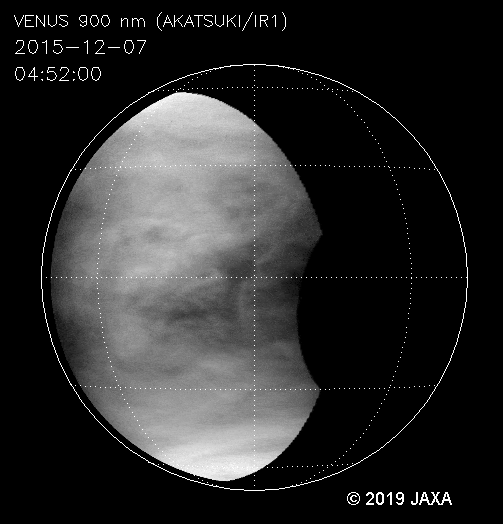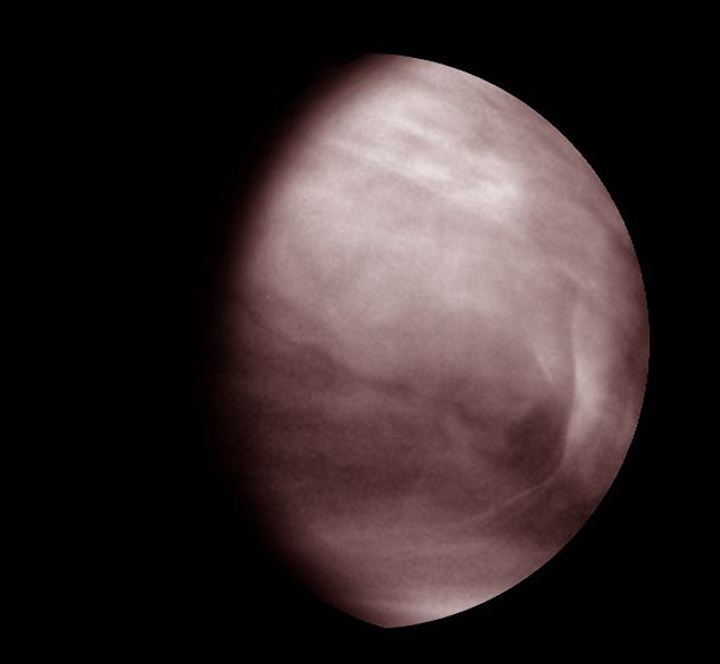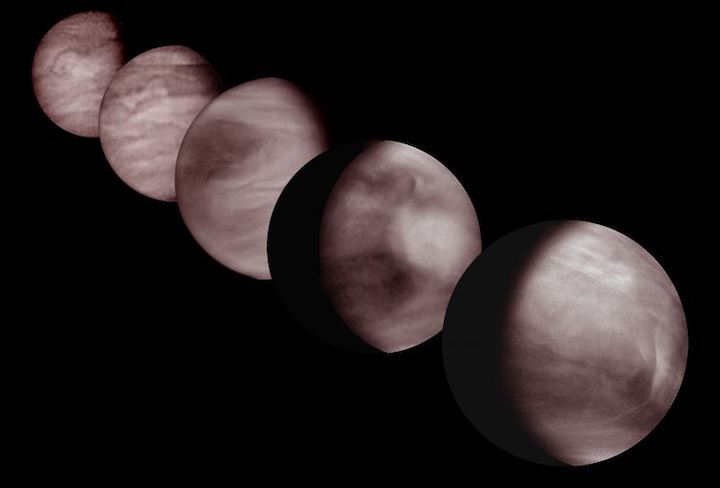5.05.2019
Venus is known for its clouds of sulfuric acid covering the entire planet and its super-fast winds moving at hundreds of kilometers per hour, but our neighboring planet’s thick clouds make it difficult for scientists to peer deep inside its atmosphere.

Animation of the middle clouds of Venus as observed with the 900-nm images from Akatsuki/IR1. Credit: Javier Peralta
Now, researchers have used infrared images to spy into the middle layer of Venus’s clouds and they have found some unexpected surprises.
The new research, published in the AGU journal Geophysical Research Letters, finds this middle layer of clouds shows a wide variety of cloud patterns that change over time and are very different from the upper layer of Venus’s clouds, which are usually studied with ultraviolet images. The study also found changes in the albedo of the middle clouds, or how much sunlight they are reflecting back to space, which could indicate the presence of water, methane or other compounds absorbing solar radiation.

The middle clouds of Venus as observed on the evening side at 900-nm by the camera IR1 onboard JAXA’s orbiter Akatsuki. This image was acquired the 1 of July of 2016, and it exhibits an example of the hemispherical asymmetry and sharp contrasts apparent on the albedo. Credits: JAXA.
The motions of the middle clouds, combined with previous observations, allowed researchers to reconstruct a picture of the winds on Venus over 10 years, showing the super-fast winds in the planet’s middle clouds are fastest at the equator and, like the upper clouds, change speed over time.
These new observations could help scientists better understand our neighboring planet and shed light on other planets and exoplanets with similar features, according to the study’s authors.
“We observed completely unexpected events,” said Javier Peralta, ITYF researcher at the Japan Aerospace Exploration Agency (JAXA) and lead author of the new study. “We have discovered that the middle clouds are not as quiet or as boring as they seemed during previous missions.”

The middle clouds of Venus as observed on the morning side at 900-nm by the camera IR1 onboard JAXA’s orbiter Akatsuki. This image was acquired the 17 of May of 2016, and it exhibits an example of the hemispherical asymmetry on the albedo which re-appeared every 4-5 days during this stage of the mission. Credits: JAXA.
Observing Venus’s clouds
The new study used images taken by JAXA’s Akatsuki spacecraft, which arrived at Venus in December 2015 and whose main goal is to understand Venus’s super-rotation. Super-rotation is a puzzling phenomenon also seen on Titan and many exoplanets that makes the atmosphere move much faster than the solid planet. It takes Venus 243 Earth days to complete a rotation. However, it takes only four Earth days for the planet’s atmosphere to go all the way around Venus – about 60 times faster than the planet’s rotation.
In the new study, researchers analyzed nearly 1,000 infrared images of Venusian clouds captured by one of Akatsuki’s cameras over one year. The camera was designed to observe the middle cloud layer, which sits 50 to 55 kilometers above the planet’s surface. Photons at infrared wavelengths can penetrate deeper into the clouds before being reflected, allowing scientists to peer deeper into this cloud layer.
Previous missions studying Venus’s top-most clouds have seen glimpses of the middle cloud layer but had been unable to get a good, long look at it with infrared images. In order to see how the middle clouds evolve, instruments have to look at them for a longer time than was done during previous missions, according to Peralta.

The strong variability of the middle clouds of Venus as shown in 900-nm mages acquired by the camera IR1 onboard JAXA’s orbiter Akatsuki during the year 2016. Clear hemispherical asymmetries, zonally-oriented stripes and sharp discontinuities are visible on the middle clouds’ albedo. Image dates (from left to right): 2, 3 and 17 of May, 23 of June and 1 of July. Credits: JAXA.
The new images taken by Akatsuki show the middle layer of clouds change over time and are also very different than Venus’s upper cloud layer, which sit at a height of about 70 kilometers. Sometimes, the images show a slightly darker band of clouds invaded by bright clouds that at times exhibit swirl shapes or look mottled. These observations are suggestive of convection, the vertical movement of heat and moisture in the atmosphere. On Earth, convection can cause thunderstorms. At other times, the images showed clouds that are less turbulent and appear homogeneously bright or featureless, with multiple stripes.
From April to May of 2016, Venus’s northern hemisphere became periodically darkened every four to five days. Scientists had not previously observed this difference between the hemispheres and the cause is yet to be determined, according to the new study. The images also showed other rare cloud features, including a hook-like dark filament extending more than 7,300 kilometers in the northern hemisphere in May and October of 2016.
Akatsuki also saw unexpected high contrasts in the cloud albedo. The new study suggests there could be compounds in the cloud layer able to absorb at the infrared wavelength or, alternatively, there could changes in the thickness of the clouds.
The scientists have also reconstructed Venus’s winds over 10 years by combining the Akatsuki images with observations by amateur observers and past missions like ESA’s Venus Express and NASA’s MESSENGER mission. They found the super-rotating winds in Venus’s middle clouds are sometimes fastest at the equator and their speed could change by up to 50 kilometers per hour over several months.

The strong variability of the middle clouds of Venus as shown in 900-nm mages acquired by the camera IR1 onboard JAXA’s orbiter Akatsuki during the year 2016. Clear hemispherical asymmetries, zonally-oriented stripes and sharp discontinuities are visible on the middle clouds’ albedo. Image dates (from left to right): 3 and 17 of May, 23 of June and 1 of July. Credits: JAXA.
Understanding Venus’s super-rotation
The findings could help scientists better understand Venus’s super-rotation. The frictional drag and mountain waves caused by Venus’s surface or the periodic heating from the Sun are factors that could be playing a key role in the maintenance of the super-rotation by slowing down or accelerating the winds and defining its long-term evolution, according to Peralta.
Since most of the solar energy is absorbed in the cloud layers and the fastest super-rotating winds also occur there, studying several layers of the clouds is critical to understanding the winds, according to Peralta. Scientists suspect changes in Venus’s clouds and their albedo could be linked to the planet’s super-rotation, and how the wind’s momentum and energy is transported.
Uncovering the cause of the super-rotation on Venus and its potential connection to the planet’s runaway greenhouse effect might help scientists understand changes on Earth related to climate change, Peralta said. It could also shed light on the atmospheric super-rotation of other bodies in our solar system like Saturn’s moon Titan, and exoplanets orbiting very close to their stars, he said.
Quelle: AGU
